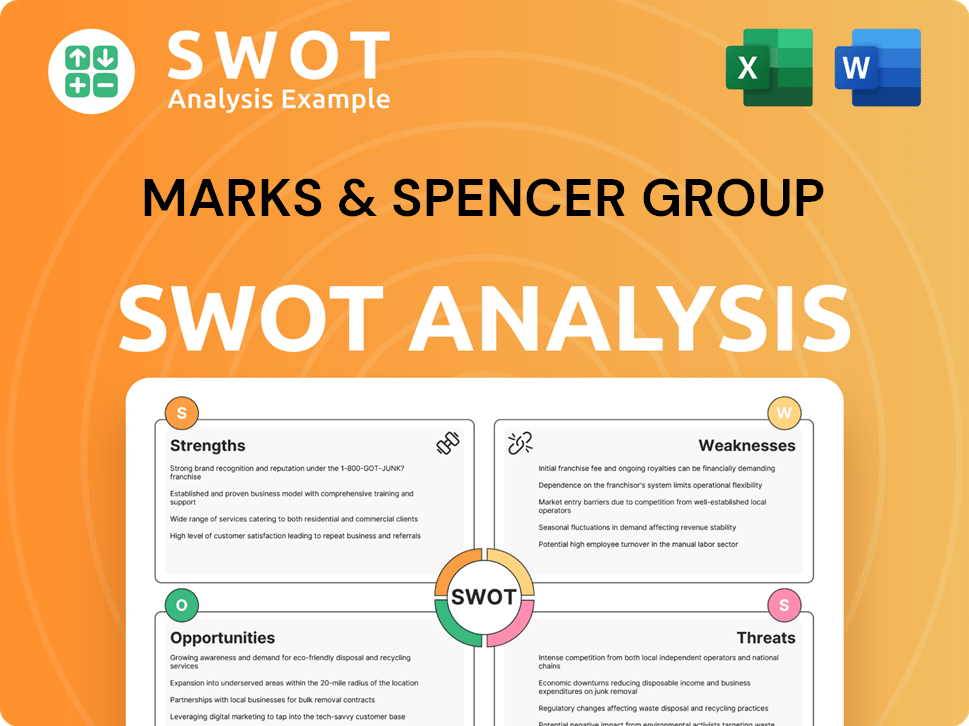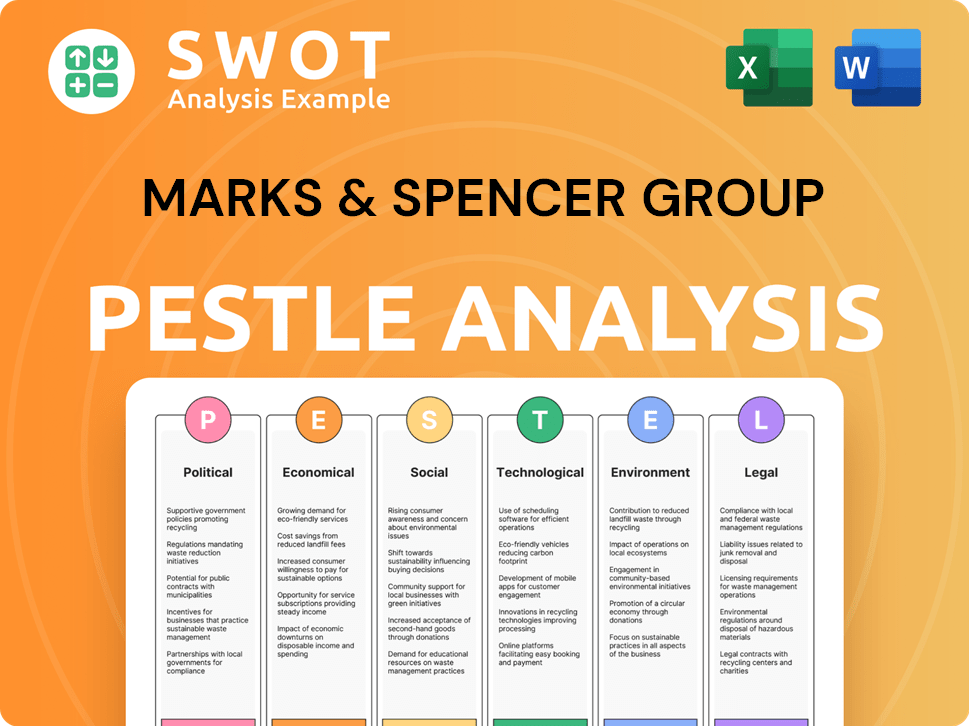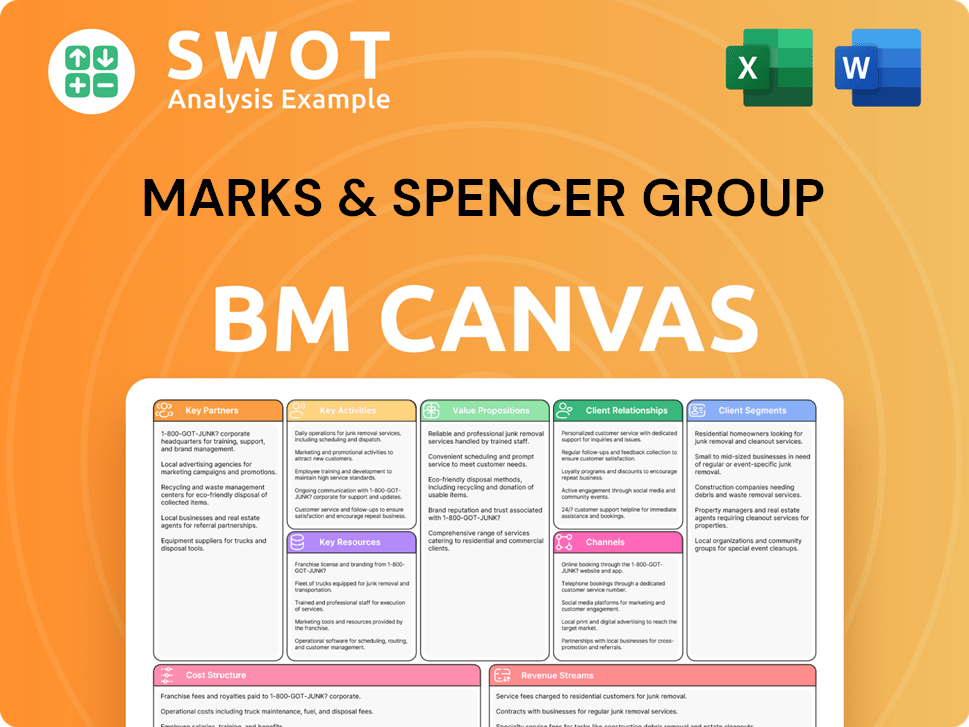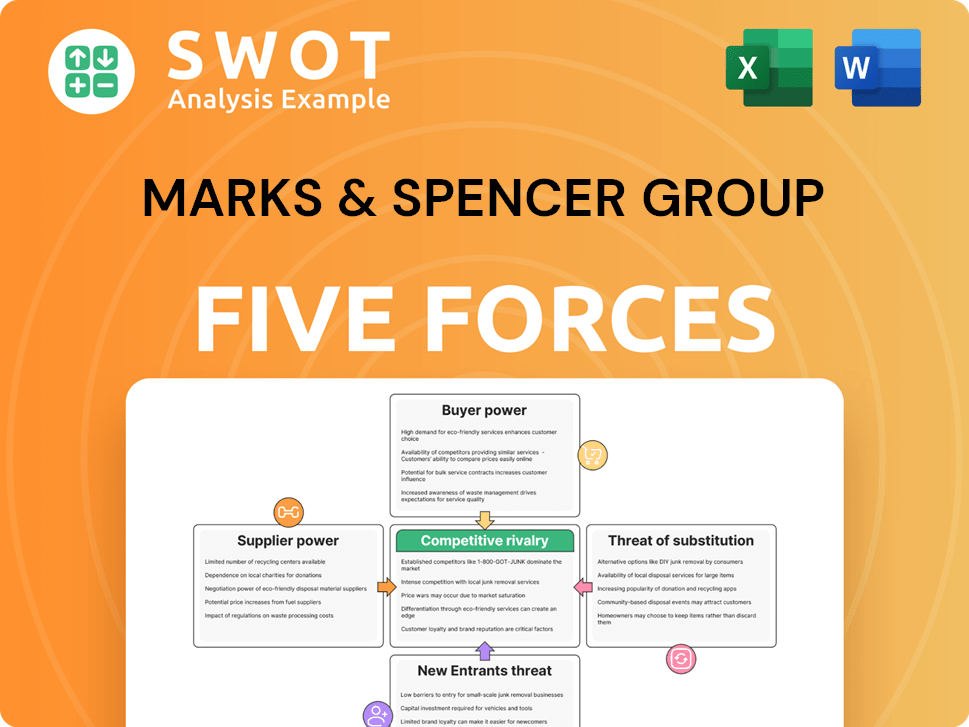Marks & Spencer Group Bundle
Can Understanding M&S's Customers Shape Its Future?
Marks & Spencer (M&S), a retail giant, is constantly evolving, and understanding its Marks & Spencer Group SWOT Analysis is crucial for its success. Navigating the dynamic retail industry requires a deep dive into its customer demographics and target market. This analysis goes beyond mere demographics; it’s about understanding the heart of M&S's business strategy and its ability to adapt to changing consumer preferences.

This exploration will dissect who the current M&S customers are, providing insights into their consumer profile, shopping habits, and where they live. We'll examine the age range, income levels, and product preferences of various customer segments to understand how M&S defines its target market. By analyzing M&S's customer segmentation and marketing strategies, we'll uncover how the company aims to capture and retain its ideal customer in today's competitive retail landscape, considering the significant shifts in the UK and beyond.
Who Are Marks & Spencer Group’s Main Customers?
Understanding the customer demographics and target market is crucial for the success of any retail business. For the well-known retailer, this involves analyzing its primary customer segments across its clothing, home, and food divisions. The company has historically catered to a specific demographic, but it has also adapted its strategies to broaden its appeal and stay relevant in the competitive retail industry.
The company's target market has evolved over time, reflecting changes in consumer preferences and market dynamics. The company's food division, in particular, has seen strong growth, indicating a solid customer base that values quality and convenience. By examining the key customer segments and their evolving needs, the company can refine its strategies and maintain a competitive edge.
The company's customer base is primarily composed of consumers (B2C), with distinct segments across its clothing, home, and food divisions. The company's core demographic has historically been women aged 50 and above, often associated with its classic and reliable clothing lines. However, recent strategic shifts have aimed to broaden this appeal.
The clothing and home segments are actively working to attract younger customers. This involves more contemporary designs and collaborations to resonate with women in their 30s and 40s. The goal is to compete with online retailers and fast-fashion brands by offering more fashion-forward collections and increasing the online presence.
The food division targets a more affluent customer base, including families and individuals. These customers prioritize quality, ethical sourcing, and convenience. They are willing to pay a premium for these attributes. The food business consistently outperforms clothing and home divisions in terms of like-for-like sales growth.
The company also caters to customers who value sustainability and ethical practices. This aligns with its Plan A commitments, which focus on environmental and social responsibility. The company aims to meet the needs of a diverse customer base by offering a range of products and services.
The company's customer segmentation strategy focuses on understanding the needs and preferences of different customer groups. This allows the company to tailor its products, marketing, and customer service to meet the specific needs of each segment. This approach helps the company to stay competitive and relevant in the market. For more information, you can read about the Growth Strategy of Marks & Spencer Group.
The company's strategic shifts aim to broaden its customer base. This includes attracting younger customers in clothing and home, and catering to an affluent customer base in food. The company's food business saw an 8.9% increase in sales in Q3 2023/24, indicating strong growth. This growth is driven by busy professionals and families seeking high-quality, convenient meal solutions.
- Women Aged 50+: Historically the core customer for clothing, with a focus on classic and reliable styles.
- Women in Their 30s and 40s: Targeted through more contemporary designs and collaborations in clothing and home.
- Affluent Families and Individuals: Prioritize quality, ethical sourcing, and convenience in the food division.
- Customers Valuing Sustainability: Aligning with Plan A commitments to meet the needs of environmentally conscious consumers.
Marks & Spencer Group SWOT Analysis
- Complete SWOT Breakdown
- Fully Customizable
- Editable in Excel & Word
- Professional Formatting
- Investor-Ready Format

What Do Marks & Spencer Group’s Customers Want?
Understanding the customer needs and preferences is crucial for the success of any retailer. For Marks & Spencer Group, this involves a deep dive into what drives their customers' purchasing decisions. The company's approach is multifaceted, considering both the practical needs and the aspirational desires of its diverse customer base. This dual focus helps to tailor products and marketing efforts effectively.
In the food sector, customers prioritize quality, freshness, and convenience. They seek premium ingredients, ready meals, and everyday essentials that offer superior taste and provenance. In clothing, the emphasis shifts to quality fabrics, good fit, and durability, reflecting a move away from fast fashion. Customers are increasingly drawn to versatile pieces suitable for various occasions, mirroring a more relaxed lifestyle. Psychological factors, such as trust in the brand, also play a significant role.
M&S addresses customer pain points by focusing on consistent sizing in clothing and providing convenient, healthy food options. Customer feedback drives product development, leading to innovations like extended sizing ranges and a wider variety of plant-based food options. Marketing strategies are tailored to showcase diverse models in clothing campaigns and highlight the quality and sourcing of food ingredients. The 'Sparks' loyalty program offers personalized promotions, enhancing the customer experience and fostering loyalty.
Customers of M&S in the food sector are highly driven by the quality and freshness of products. They are looking for premium ingredients that provide a superior taste experience. This focus is evident in the strong performance of prepared meals and fresh produce categories.
In clothing, customers value quality fabrics, good fit, and durability. This preference reflects a move away from fast fashion. Versatile pieces that can be dressed up or down are increasingly popular, aligning with more casual lifestyles.
Psychological drivers include trust in the M&S brand for reliability and a sense of affordable luxury. Customers often associate the brand with consistent quality and value, making it a trusted choice for various needs.
M&S addresses customer pain points by focusing on consistent sizing in clothing and providing convenient, healthy food options. Feedback from customers directly influences product development and innovation.
Marketing strategies are tailored to showcase diverse models in clothing campaigns and highlight the quality and sourcing of food ingredients. The 'Sparks' loyalty program offers personalized promotions, enhancing the customer experience.
M&S has expanded its plant-based food options to cater to diverse dietary preferences. This is a direct response to customer demand for more sustainable and health-conscious choices.
Understanding the customer demographics and target market of M&S involves recognizing their key preferences and needs. This includes a focus on quality, convenience, and value across both food and clothing categories. M&S's ability to adapt to changing consumer behaviors is critical.
- Quality and Freshness: Customers seek high-quality ingredients and fresh produce.
- Durability and Fit: Clothing must offer good fit, quality fabrics, and durability.
- Convenience: Ready meals and easy-to-wear clothing are highly valued.
- Brand Trust: Customers trust M&S for reliability and affordable luxury.
- Versatility: Demand for versatile clothing that can be dressed up or down.
Marks & Spencer Group PESTLE Analysis
- Covers All 6 PESTLE Categories
- No Research Needed – Save Hours of Work
- Built by Experts, Trusted by Consultants
- Instant Download, Ready to Use
- 100% Editable, Fully Customizable

Where does Marks & Spencer Group operate?
The primary geographical market for the company is the United Kingdom, where it has a significant presence. The company operates a wide variety of stores across the UK, from large retail parks to smaller food-only outlets. It holds a strong market share in the UK for both clothing and food, with the food business generally performing better.
Historically, the company had an international presence, but this has been restructured in recent years. The focus has shifted towards strengthening the core UK business and leveraging its online platform for growth. This strategic move allows the company to reach a broader audience without the overhead of physical stores in every market.
The company's online presence is significant, serving both UK and international customers. This strategy allows it to maintain a global reach while optimizing its physical store footprint. The company's approach to its target market is also influenced by regional variations within the UK.
The UK remains the company's most important market, with a vast network of stores. These range from large out-of-town locations to smaller high-street and railway station outlets. The company’s strong brand recognition and market share in both clothing and food underscore its UK dominance. The food business, in particular, has shown consistent growth.
The company has strategically withdrawn from several international markets to focus on its core UK business and online presence. This shift allows the company to concentrate on its most profitable ventures and adapt to changing consumer behaviors. The focus is now on leveraging the online platform for growth.
The company has a significant online presence, serving both UK and international customers. This allows the company to reach a broader audience without the overhead of physical stores in every market. The online platform is a key component of its growth strategy.
Differences in customer demographics and preferences are evident even within the UK. The company adapts its store formats to suit different locations. For instance, smaller food stores in urban centers cater to commuters. This localized approach helps the company to better serve its diverse customer base.
The company's strategic decisions have focused on strengthening its core UK business and leveraging its online platform for growth. This approach is in response to changing consumer behaviors and market conditions. The company is adapting to the evolving retail landscape by focusing on its strengths and online capabilities. For more insights, explore the Marketing Strategy of Marks & Spencer Group.
- The UK market remains the primary focus, with a strong retail presence.
- International expansion has been scaled back in favor of a stronger UK presence.
- Online sales are a key growth driver, expanding the company's reach.
- The company adapts its offerings to suit regional preferences within the UK.
Marks & Spencer Group Business Model Canvas
- Complete 9-Block Business Model Canvas
- Effortlessly Communicate Your Business Strategy
- Investor-Ready BMC Format
- 100% Editable and Customizable
- Clear and Structured Layout

How Does Marks & Spencer Group Win & Keep Customers?
The customer acquisition and retention strategies of Marks & Spencer (M&S) are designed to attract new customers while fostering loyalty among existing ones. M&S employs a blend of traditional and digital marketing techniques to reach its target market, ensuring a consistent brand presence across various channels. These strategies are crucial for navigating the competitive retail industry and maintaining a strong consumer profile.
M&S leverages digital channels, including social media, email marketing, and search engine optimization, to engage with a broader and younger audience. The company uses influencer collaborations and engaging content to promote its fashion and lifestyle offerings, aiming to capture the attention of potential customers. Simultaneously, M&S continues to utilize traditional advertising methods, such as television commercials and print media, particularly for its food campaigns, emphasizing quality and seasonal produce.
A key component of M&S's retention strategy involves its 'Sparks' loyalty program, which offers personalized rewards, exclusive discounts, and tailored content based on customer purchasing history. This program aims to create a sense of loyalty and encourage repeat purchases. In addition, M&S focuses on providing excellent after-sales service, including easy returns and customer support, to enhance the overall customer experience. This multifaceted approach is designed to build lasting relationships with customers, enhancing customer lifetime value and reducing churn rates.
M&S actively uses social media platforms, email marketing, and SEO to enhance its reach. These digital efforts are crucial for attracting a wider audience and driving online sales. The company also uses influencer collaborations and engaging content to promote its products and services.
Traditional advertising methods, such as television commercials and print media, remain important. These channels are particularly effective for promoting M&S's food campaigns. These campaigns emphasize quality and seasonal produce to attract customers.
The 'Sparks' loyalty program is a cornerstone of M&S's retention strategy. It offers personalized rewards, exclusive discounts, and tailored content. This program fosters loyalty and encourages repeat purchases, which is essential for long-term success.
Excellent after-sales service, including easy returns and customer support, is a priority. M&S aims to enhance the overall customer experience by providing seamless and helpful service. This focus helps in building strong customer relationships.
M&S utilizes customer data and CRM systems to segment its audience and deliver targeted marketing campaigns. This approach ensures that promotions and communications are relevant to individual customer preferences. This approach helps to improve the effectiveness of marketing efforts.
- Customer Segmentation: M&S segments its customer base to tailor marketing messages.
- Personalized Campaigns: Targeted campaigns are designed based on customer preferences and purchase history.
- CRM Systems: Customer Relationship Management systems are used to manage and analyze customer data.
- Improved ROI: Data-driven marketing helps in achieving a better return on investment.
M&S is investing in digital transformation to improve the online shopping experience and integrate it with in-store offerings. This omnichannel approach aims to provide a consistent and convenient shopping journey across all touchpoints. This strategy enhances customer lifetime value.
The focus on omnichannel retail and personalized experiences aims to enhance customer lifetime value. By providing a seamless shopping experience, M&S increases customer loyalty and reduces churn rates. This approach is critical for long-term success.
These strategies directly impact customer loyalty, with the goal of turning one-time shoppers into repeat customers. Increased loyalty leads to higher sales and a more stable customer base. This is a key metric for measuring success.
By focusing on customer retention, M&S aims to reduce churn rates. Retaining existing customers is often more cost-effective than acquiring new ones. This is a critical factor in profitability.
M&S's digital transformation efforts include improvements to its website and mobile app. Enhanced digital platforms provide a better shopping experience. These improvements are designed to boost online sales.
Integrating online and in-store experiences helps customers shop seamlessly. This integration includes options like click-and-collect and in-store returns. It enhances the overall shopping experience.
For further insights into the company's strategic adjustments and market positioning, explore the detailed analysis of how Marks & Spencer makes money.
Marks & Spencer Group Porter's Five Forces Analysis
- Covers All 5 Competitive Forces in Detail
- Structured for Consultants, Students, and Founders
- 100% Editable in Microsoft Word & Excel
- Instant Digital Download – Use Immediately
- Compatible with Mac & PC – Fully Unlocked

Related Blogs
- What are Mission Vision & Core Values of Marks & Spencer Group Company?
- What is Competitive Landscape of Marks & Spencer Group Company?
- What is Growth Strategy and Future Prospects of Marks & Spencer Group Company?
- How Does Marks & Spencer Group Company Work?
- What is Sales and Marketing Strategy of Marks & Spencer Group Company?
- What is Brief History of Marks & Spencer Group Company?
- Who Owns Marks & Spencer Group Company?
Disclaimer
All information, articles, and product details provided on this website are for general informational and educational purposes only. We do not claim any ownership over, nor do we intend to infringe upon, any trademarks, copyrights, logos, brand names, or other intellectual property mentioned or depicted on this site. Such intellectual property remains the property of its respective owners, and any references here are made solely for identification or informational purposes, without implying any affiliation, endorsement, or partnership.
We make no representations or warranties, express or implied, regarding the accuracy, completeness, or suitability of any content or products presented. Nothing on this website should be construed as legal, tax, investment, financial, medical, or other professional advice. In addition, no part of this site—including articles or product references—constitutes a solicitation, recommendation, endorsement, advertisement, or offer to buy or sell any securities, franchises, or other financial instruments, particularly in jurisdictions where such activity would be unlawful.
All content is of a general nature and may not address the specific circumstances of any individual or entity. It is not a substitute for professional advice or services. Any actions you take based on the information provided here are strictly at your own risk. You accept full responsibility for any decisions or outcomes arising from your use of this website and agree to release us from any liability in connection with your use of, or reliance upon, the content or products found herein.